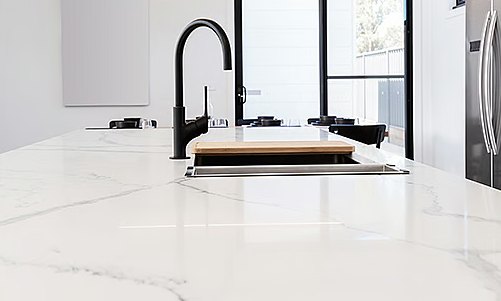When selecting materials for home design, dark gray quartz offers a blend of sophistication and functionality that has made it increasingly popular in modern interiors. Here, we break down the advantages and disadvantages of incorporating dark gray quartz into your living spaces.
Pros of Dark Gray Quartz
Elegant Aesthetic
Dark gray quartz brings a sleek, contemporary look to any room. Its neutral color pairs well with a wide range of color schemes, from bold and dramatic to soft and minimalist. The color’s versatility allows it to be a fit for various design styles, enhancing the overall aesthetic appeal of the space.
Durability and Maintenance
Quartz is known for its durability. It’s highly resistant to scratches and chips, which makes dark gray quartz a practical choice for high-traffic areas like kitchens and bathrooms. Additionally, unlike natural stone, quartz does not require regular sealing, making maintenance a breeze. A simple cleaning routine with soap and water is typically enough to keep it looking pristine.
Consistency in Appearance
Unlike natural stones, which can vary widely in appearance, quartz is engineered to provide a consistent look across all slabs. This consistency ensures that when you select dark gray quartz, you won’t have surprises in color or pattern variation, which is especially important for large projects or matching different sections of a workspace.
Cons of Dark Gray Quartz
Limited Natural Look
While quartz does offer consistency in appearance, it lacks the natural variegation and unique character that stones like granite or marble have. For those who value the distinctiveness of natural stone, dark gray quartz might feel too uniform or artificial.

Heat Sensitivity
Despite its durability, quartz is not completely resistant to heat. High temperatures can cause damage such as discoloration and cracking. Therefore, it’s recommended to use trivets or hot pads when placing hot items directly on dark gray quartz countertops to avoid potential damage.
Potential for Visible Smudges and Fingerprints
The darker color of gray quartz can sometimes show fingerprints, smudges, and dust more readily than lighter colored countertops. This means it might require more frequent cleaning to keep the surfaces looking spotless, which could be a consideration for busy households.
Cost Considerations
Quartz is generally more expensive than some other countertop materials, such as laminate. The cost of dark gray quartz can vary, but it typically ranges from $50 to $120 per square foot installed, depending on the brand and the complexity of the installation. While the investment may be higher initially, the durability and longevity of quartz often provide value over time.
Wrapping Up
Dark gray quartz offers a perfect combination of beauty and practicality for those looking to modernize their homes with a reliable material. However, it’s essential to weigh its sleek and uniform appearance against its cost and maintenance needs to determine if it’s the right fit for your design goals and lifestyle.
For more insights and detailed comparisons of quartz countertops, including dark gray options, visit dark gray quartz. This resource will help you explore further the qualities and considerations of using quartz in your home projects.